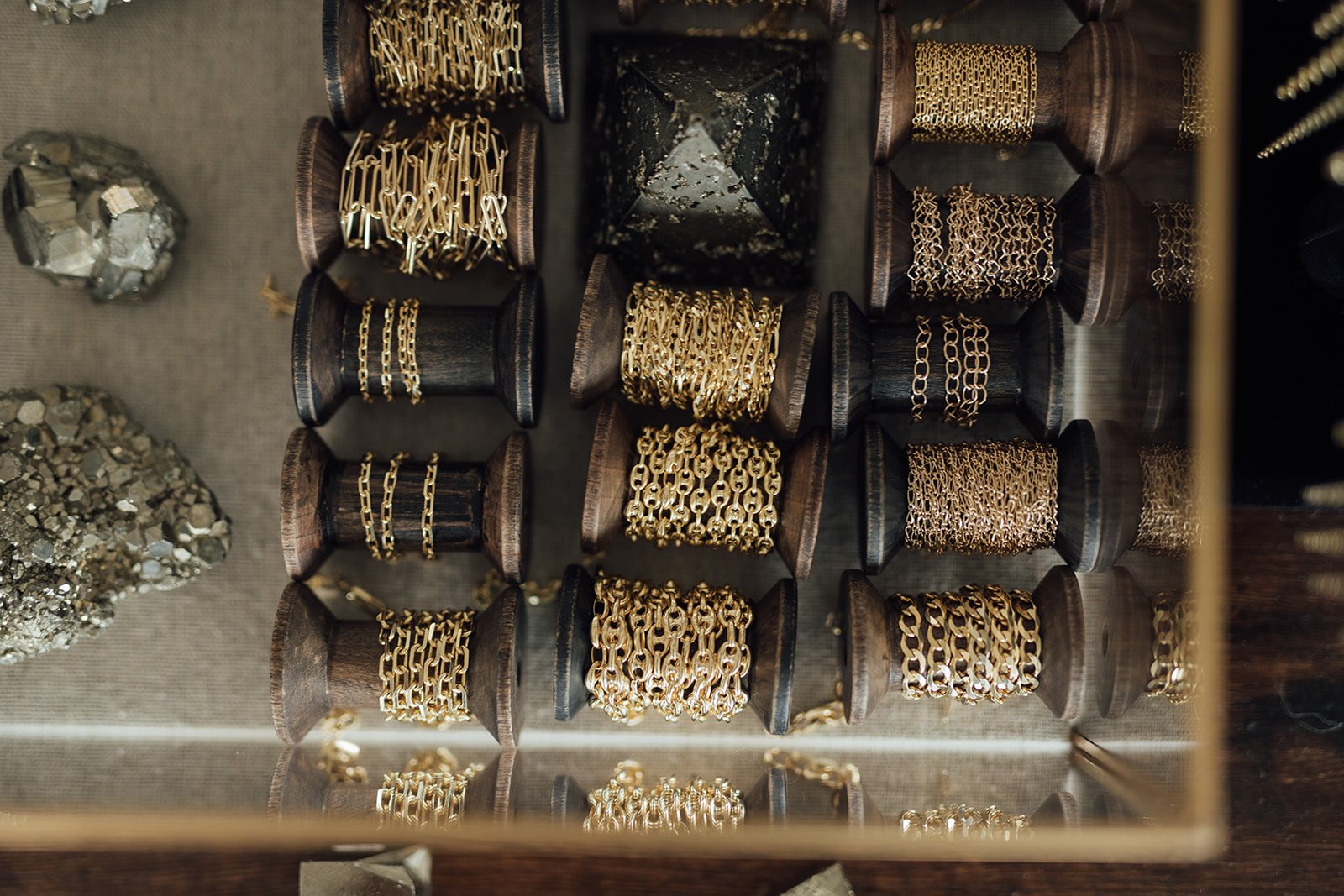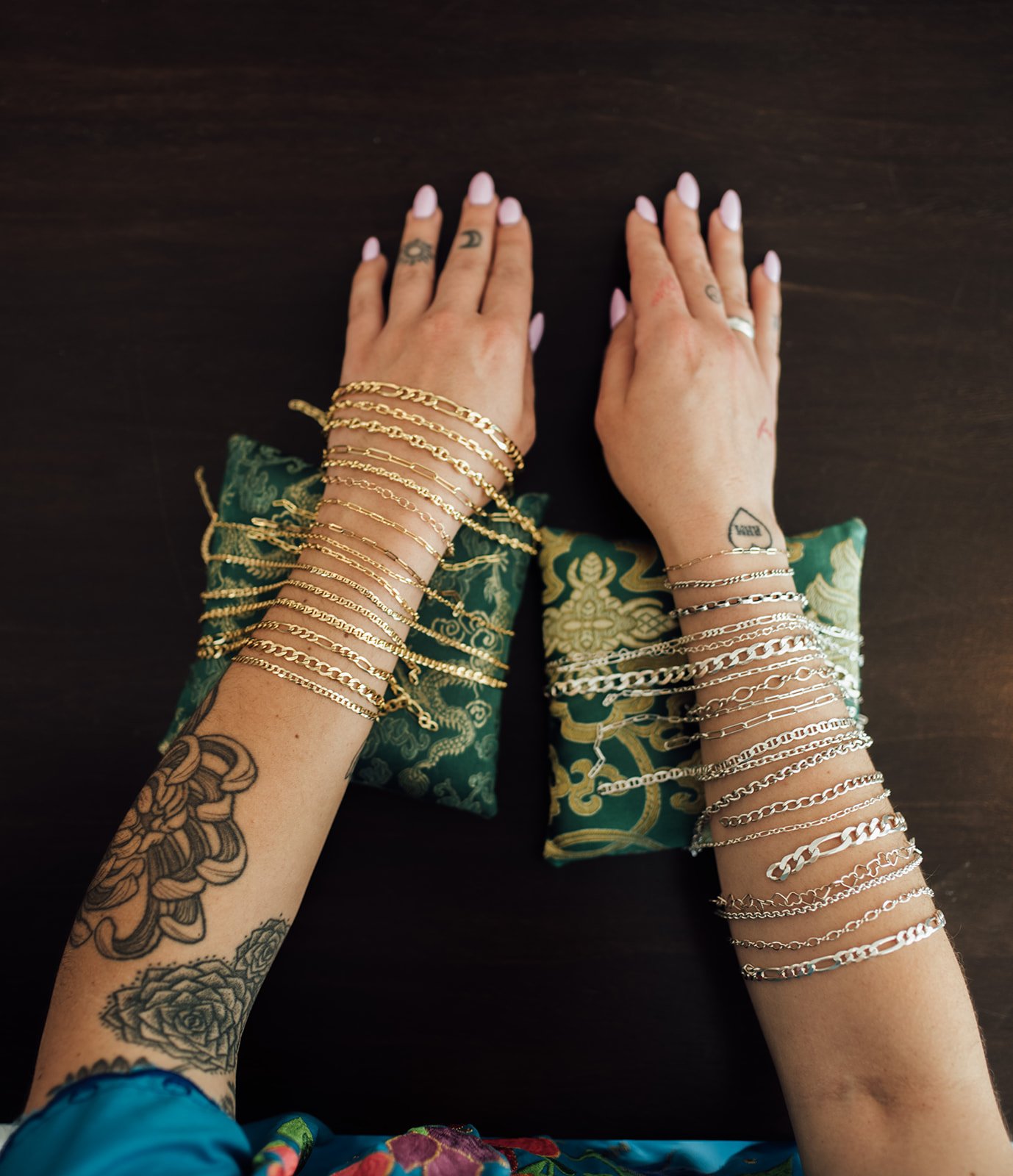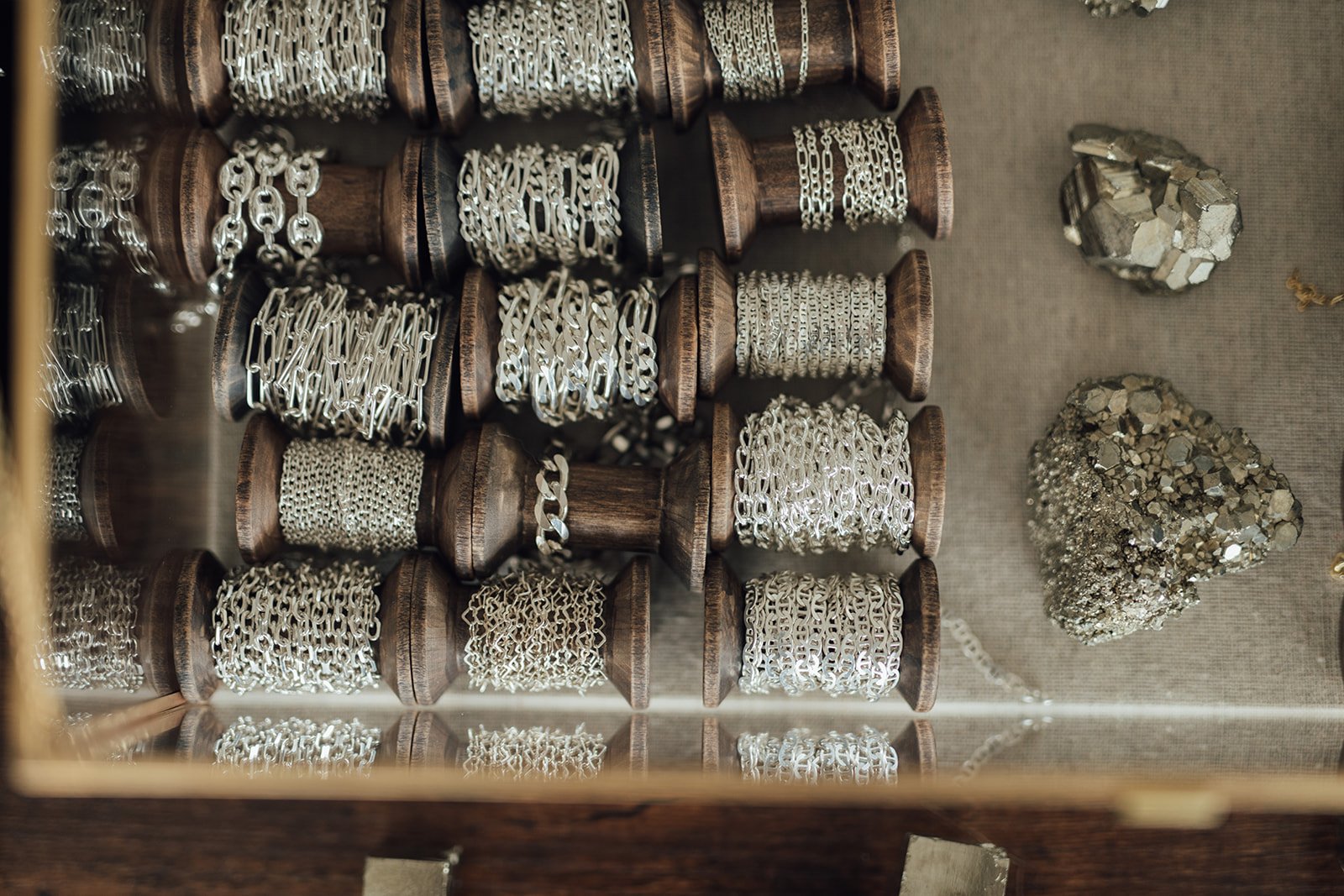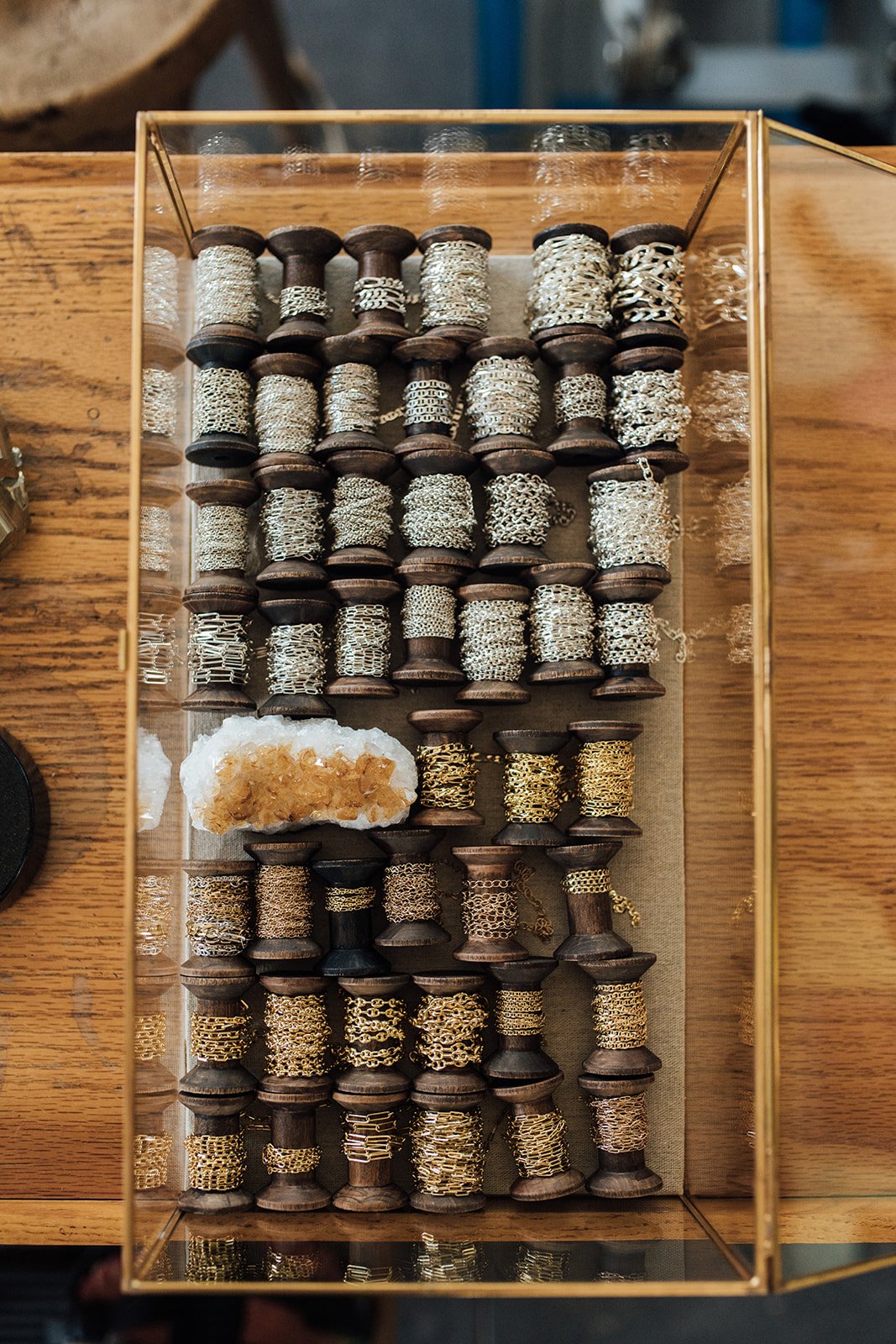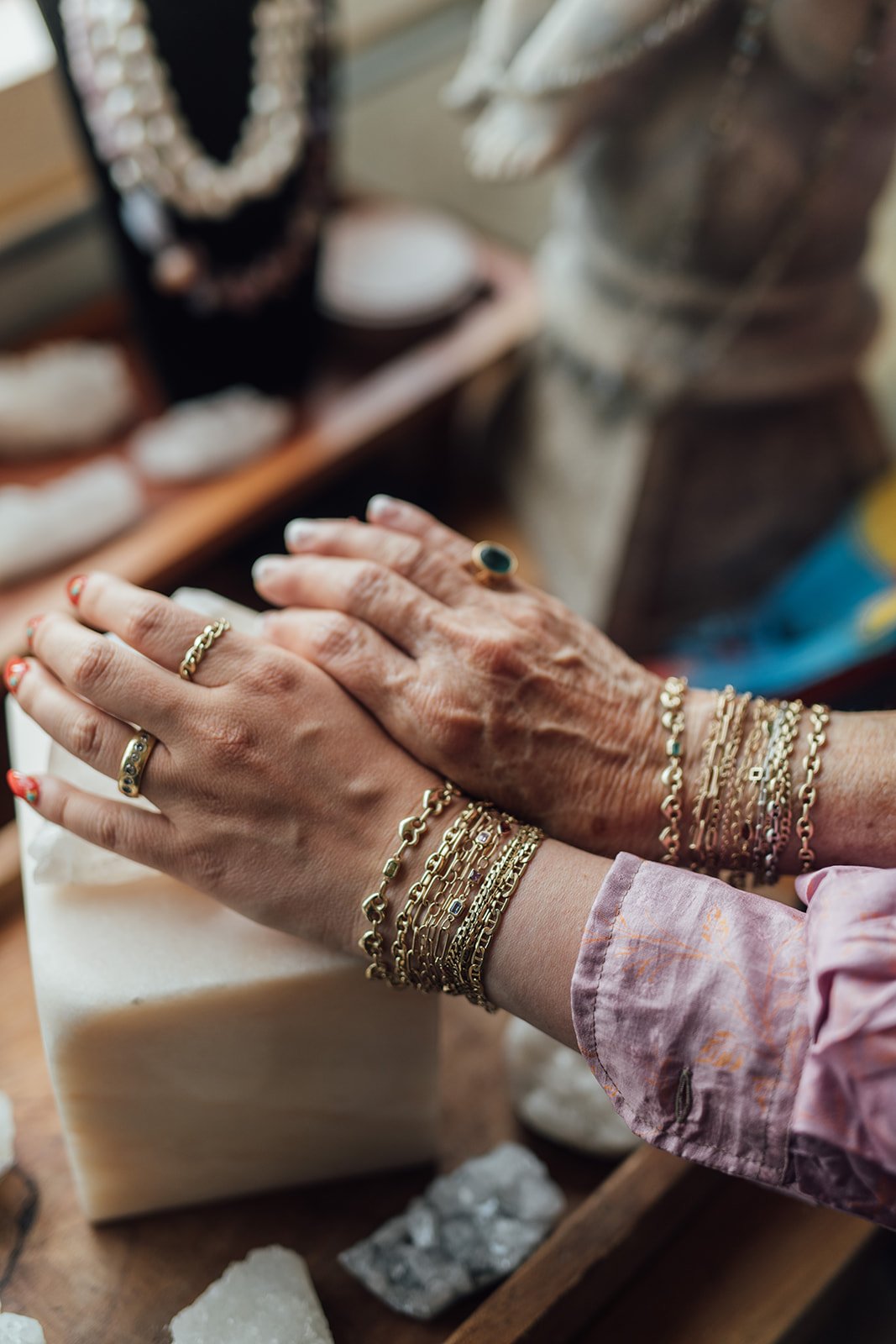LET’S LEARN ABOUT SILVER & GOLD
At Love Saro, we work exclusively in 925 sterling silver and solid 14k yellow gold.
We choose to work in sterling silver and 14k yellow gold for their individual durability, color and versatility.
These metals are perfect for daily wear as they are highly performative, durable, comfortable for the most sensitive skin, and most importantly - they age beautifully.
CHOOSING SILVER & GOLD MEANS CHOOSING JEWELRY MADE TO LAST
Creating your special and personal piece of custom jewelry with Love Saro means creating a piece you can wear and carry with you always. Fine jewelry is meant to be lived in. Much like our own vessels, gold and silver will experience interaction with the world as you move through it, building character over time. Sterling Silver and solid gold allow your creations to stay as precious as the day you designed them.
WE LOVE STERLING SILVER
For centuries, Sterling Silver has been highly sought after due to its lustrous beauty and versatility.
Sterling Silver has been historically used in jewelry, home décor, and utensils for fine dining - all making life a bit shinier. 925 Sterling Silver is created from 92.5% silver. Pure silver is too soft to be used alone, thus an alloy of mixed metals is added to toughen the metal for daily use. This is the most pure form of silver that you can find for jewelry and housewares alike.
Unlike gold, Silver is not resistant to tarnishing.. HOWEVER, when worn every day, the metal keep can avoid tarnishing with daily showering and the interaction of wearing multiple silver bracelets together.
Tarnishing or oxidation occurs when silver interacts with a number of chemicals. The most common chemical that silver experiences tarnishing from is Sulphur which is frequently present in moist environments… Common oils in moisturizers, detergents, shampoos, perfumes, deodorants, and soaps can also cause tarnishing. Our bodies' own acids can also cause tarnishing, although less common.
Our individual bodies will interact with silver differently. On some, silver stays white and bright, while others naturally patina silver to a gunmetal, worn in tone. Each of our bodies adds unique character to silver within a range of shades and tones. This is entirely due to our body’s unique chemistry. This reaction proves that silver is actually pure.
Wearing silver daily can prevent it from experiencing tarnishing. Our bodies' natural oils can maintain their brilliance. A jewelry polishing cloth can provide an efficient and easy way to clean your jewelry. Silver polishing cloths are infused with a specific silver-polishing compound.
At Love Saro, our team has worn our silver jewelry everywhere from hot springs, pools, to our favorite hot yoga classes with no tarnishing. We have not personally experienced tarnishing with our products considering our daily wear and care - but everyone is different!
Like gold, sterling silver will patina naturally over time. It is a softer metal and therefore will develop character over time with wear. Want to learn more? Visit our METALS FAQ!
WE LOVE GOLD
In ancient bazaars, the seeds of carob trees were used to balance the scales that measured the weight of gold. In turn, creating the term “Karat” to describe the level of purity for gold.
Long desired for its beautiful hue and adaptable nature, gold has been used in everything from jewelry, medicine, decoration, money, to technology. In fine jewelry, gold is alloyed with a propriety mix of metals to harden the metal for daily wear. The amount of gold in a piece can be determined by its Karat - commonly marked as K. Karat refers to the amount of pure gold found in a piece of jewelry. The purity of solid Gold ranges from 9k to 24k.
WHICH KARAT AMOUNT IS RIGHT FOR YOU?
24k is considered the purest amount of gold - at 99.99% gold content. 24k gold produces a rich, buttery yellow color but is extremely, extremely soft and delicate as no other metals are added to it - thus is not suitable for daily wear.
18k commonly used in fine jewelry. Its alloy is tested as 75% gold, 18k is durable, but still relatively soft enough to experience scratches and changes to its shape or setting from daily wear due to its malleability.
14k is also commonly used in fine jewelry and considered to be 58% pure gold. In the United States, it is the most common karat weight used in fine jewelry and engagement rings, specifically. We use solid 14k gold in most of our jewelry as we find it is suited best for permanent, daily wear and the most active of lifestyles.
10k is considered the most durable - with 41.7% pure gold content. We use 10k for a few of our rings as we value its durability. As 10k as a higher content level of alloyed metals - it is not considered hypoallergenic for everyone.
To create jewelry for daily wear - gold is alloyed with other metals including zinc, copper, cadmium, silver. This alloy is a proprietary mix of metals that is owned by the manufacturer and is not common or public information. Gold stamped with a karat is considered solid. Today, many jewelry companies will advertise solid gold when it is actually only finished or plated in solid gold. There is limited regulation surrounding marketing language so it is very important to read the fine print and understand what you are buying, especially when it comes to solid gold.
When worn daily, gold will naturally patina. When gold is worn next to other pieces of gold - the pieces will patina to the same tone over time. Occasionally, we might experience our skin turning black with interaction to pure gold. No need to fret - this residue easily comes off with a quick clean using soap and water or a wet wipe. This reaction is caused by gold interacting with lotions, oils, moisturizers, etc. It can also be an indicator of low iron levels in the body.
WHY NOT FILLED OR PLATED GOLD?
At Love Saro, we choose not to work in plated or filled gold materials as these are not suitable for daily, permanent wear. The process of plating, vermeil, and fill involves adding a layer of gold to a base layer of metal. Over time, the gold layer will wear off, causing the base metal to become exposed and eventually tarnished. Additionally, this type of jewelry can be irritating to sensitive skin and also leave unwanted residue on the skin.
GOLD FINISHED OR PLATED
The gold plating or finishing process involves the least amount of gold, therefore resulting in the lowest cost. A low price tag for “gold” jewelry typically indicates that the product is plated. Because the layer of gold is so thin - it quickly wears off - allowing the base metal to tarnish.
GOLD VERMEIL
The process of vermeil involves electroplating a layer of gold to silver to a base of Sterling Silver. The cost is lower, but like plating, wears off in time.
GOLD FILLED
Gold filled jewelry has the thickest amount of gold applied to a base metal. While the inner material is protected from tarnishing from daily wear, this metal is not considered hypoallergenic, cannot be reused or resized, and is not safe from reaction to harsh chemicals including chlorine.
We love the duality of Gold & Silver for its beautiful aesthetic as well as its spiritual significance.
Spiritually, Silver is seen as reminiscent of the moon. It can be used as a mirror to the soul. Due to its reflective surface, it is thought to bring reflection to the wearer and to those who view it. The nature of Silver is strong yet malleable, versatile and durable - thus it symbolizes subtle strength and endurance. As a metal, Silver is associated with sensitivity and emotions, and is used as a tool to bring a sense of balance and calmness.
Spiritually, Gold symbolizes the sun. Ancient Egyptians believed that Gold was the flesh of Ra - the God of the Sun. Warm in hue, Gold is thought to possess a high, vibrant energy. As a metal, it has been long used an a symbol for fortune, achievement, and prosperity.
Want to learn more? Visit our METALS FAQ!



